O projeto Bahia Azul que parou a cidade de Salvador para drenar os esgotos da cidade e, levá-los para bem longe da baía de todos os santos mostrou que houve redução em 21% dos casos de diarréia em crianças. Trata-se de uma reedição do clássico trabalho de John Snow, agora de forma sofisticada e bem documentada. O artigo é de autoria do Prof Maurício Barreto do Instituto de Saúde Coletiva da Universidade Federal da Bahia, que poderá enviar o artigo completo solicitando em mauricio@ufba.br
Background A city-wide sanitation intervention was started in Salvador, Brazil, in 1997 to improve sewerage coverage from 26% of households to 80%. Our aim was to investigate the epidemiological effect of this city-wide sanitation programme on diarrhoea morbidity in children less than 3 years of age.
Methods The investigation was composed of two longitudinal studies done in 1997–98 before the intervention (the sanitation programme) and in 2003–04 after the intervention had been completed. Each study consisted of a cohort of children (841 in the preintervention study and 1007 in the postintervention study; age 0–36 months at baseline) who were followed up for a maximum of 8 months. Children were sampled from 24 sentinel areas that were randomly chosen to represent the range of environmental conditions in the study site. At the start of each study an individual or household questionnaire was applied by trained fieldworkers; an environmental survey was done in each area before and after introduction of the sanitation programme to assess basic neighbourhood and household sanitation conditions. Daily diarrhoea data were obtained during home visits twice per week. The effect of the intervention was estimated by a hierarchical modelling approach fitting a sequence of multivariate regression models.
Findings Diarrhoea prevalence fell by 21% (95% CI 18–25%)—from 9·2 (9·0–9·5) days per child-year before the intervention to 7·3 (7·0–7·5) days per child-year afterwards. After adjustment for baseline sewerage coverage and potential confounding variables, we estimated an overall prevalence reduction of 22% (19–26%).
Interpretation Our results show that urban sanitation is a highly effective health measure that can no longer be ignored, and they provide a timely support for the launch of 2008 as the International Year of Sanitation

Nenhum comentário:
Postar um comentário